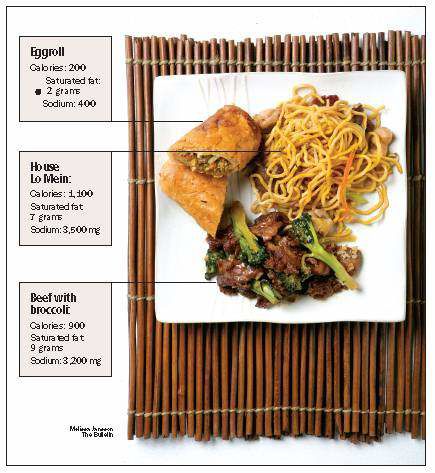Chinese food can be healthy
Published 5:00 am Thursday, April 5, 2007

- Chinese food can be healthy
Order Chinese food and there’s usually leftovers. Or at least there should be.
According to a new analysis from the Center for Science in the Public Interest, most meals at Chinese food restaurants offer two or three meals’ worth of calories, protein, fat and sodium. But the report also found that Chinese food dishes are often made with plenty of vegetables and usually cooked in heart-healthy, trans fat-free vegetable oils.
Trending
That means there are plenty of ways to eat Chinese without ending up with a lousy fortune.
Many people recall the surprising things we reported in 1993 about Chinese dishes such as Kung Pao chicken and House Lo Mein, and those dishes certainly havent gotten any better, says Michael Jacobson, executive director of the center. But lets also give credit where credit is due. Many Chinese entrees are loaded with healthy vegetables and lean shrimp or chicken.
Under current dietary recommendations, the average individual eating 2,000 calories per day should eat no more than 20 grams of saturated fat per day and no more than 2,300 milligrams of sodium. But most items on the Chinese food menu exceeded the recommended levels in one or more of those three categories in a single meal. Entrees that were low in sodium, often had plenty of saturated fat, while low-fat dishes tended to pile on the salt.
Shrimp dishes were among the healthiest choices on the menu. Szechuan shrimp or shrimp with garlic sauce had only 700 calories, while shrimp with lobster sauce had a very manageable 400 calories. However, even those shrimp dishes contained 2,000 mg to 3,000 mg of sodium.
While chicken is generally one of the leaner meats, preparation made all the difference in Chinese restaurants. Lemon Chicken, which is battered, deep-fried and then coated with a sugary sauce, had 1,400 calories and 13 grams of saturated fat. Chicken in black bean sauce had a manageable caloric load, at 700 calories, but had more sodium than any other dish analyzed. Beef dishes had a similar range of nutritional value.
Orange beef contained 1,500 calories, 11 grams of saturated fat, and 3,100 mg of sodium. Beef with broccoli had about 900 calories but still had 9 grams of fat and 3,200 mg of sodium.
Trending
The report described noodle and fried rice dishes as a load of greasy, refined carbs. A combination lo mein noodle dish packs in 1,100 calories, 7 grams of saturated fat, and 3,500 mg of sodium, while the fried rice version had 1,500 calories, 10 grams of fat and 2,700 mg of sodium.
Choosing meals with vegetables often improved the nutritional profile, but were by no means a guarantee of a healthy meal. Eggplant in garlic sauce may sound healthy but it provides 1,000 calories and 2,000 mg of sodium. Szechuan string beans or the stir-fried mixed vegetables known as Buddhas Delight had half as many calories, but both still had a full days worth of sodium (2,200 mg to 2,700 mg).
The center found that appetizers often had enough calories to count as a meal unto themselves. An order of six steamed pork dumplings, for example, contained about 500 calories. (Steaming as opposed to pan-frying saved only about 10 calories per dumpling.) The BBQ spare ribs scored worse than any other appetizer at 600 calories, 14 grams of saturated fat and 900 mg of sodium. An egg roll had about twice the calories of a spring roll, 200 calories to 100 calories, mainly because of a thicker wrapper and larger size.
For those individuals who love Chinese food but dont want to blow their diets, Bonnie Liebman, the centers director of nutrition, offers some basic advice.
Stick with the veggie-rich and stir-fried shrimp or chicken dishes, steer clear of the entrees that are basically deep-fried meat or chicken in sauce, and dont waste your calories on greasy noodles and fried rice, she says. Leaving some of the sauce behind on the platter and taking home a doggie bag can further help keep a lid on both the calories and the salt.
Diners can cut the sodium by avoiding soups, which typically have about 1,000 mg per bowl, going easy on the dipping sauces, and not adding extra soy sauce at the table. Transferring food from a serving dish to your plate with a fork or chopsticks can also cut down the amount of sauce in your meal.
Many restaurants are now used to accommodating special requests. Ask for sauces on the side or ask to have meals lightly sauteed instead of deep-fried. Substituting brown rice for white rice or fried rice can also boost the overall nutritional value.
What’s in the box
An order of Chinese food provides more than one serving of calories, saturated fat and sodium.
What you take in when you order take out
The Center for Science in the Public Interest found that many staples of Chinese food restaurants provide more than their fair share of calories, saturated fat and sodium. The nutrition advocates suggest splitting entrees with a dining partner or saving some for the next day.








